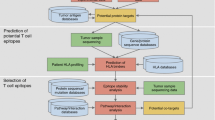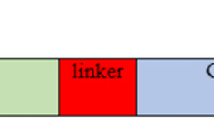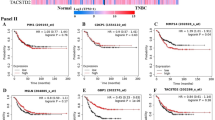Abstract
Multiple different approaches are being used to activate the immune system against breast cancer. Vaccine therapy in general follows the principle that injections of various substances ultimately result in the presentation of tumor peptides to the patient’s immune system. We proposed a potential in silico DNA vaccine against breast cancer by integrating high affinity T cell (MHC-I and MHC-II) and B cell (continuous and discontinuous) epitopes. The matching of the HLA haplotype and antigen was performed to provide the appropriate peptide epitope suitable for majority of the patients. The immunogenic nature of the antigenic construct was also enhanced by the administration of consensus epitopes. The potency of DNA vaccines depends on the efficient expression and presentation of the encoded antigen of interest and the chances of efficient expression of our antigenic construct in host organism was also verified by in silico approaches. An attempt was made to overcome the limited potency of the DNA vaccine by targeting DNA to professional antigen-presenting cells (APCs). A higher immune response theoretically corresponds to a higher survival rate of patients. Therefore, optimization studies were also employed to enhance the immunogenicity of proposed in silico DNA vaccine.








Similar content being viewed by others
References
Akhoon BA, Gupta SK, Verma V, Dhaliwal G, Srivastava M, Gupta SK, Ahmed RF (2010) In-silico designing and optimization of anti-Breast cancer antibody mimetic oligopeptide targeting HER-2 in Women. J Mol Graph Model 28:664–669
Bei R, Masuelli L, Moriconi E, Visco V, Moretti A, Kraus MH, Muraro R (1999) Immune responses to all ErbB family receptors detectable in serum of cancer patients. Oncogene 18:1267–1275
Blythe MJ, Flower DR (2005) Benchmarking B-cell epitope prediction: underperformance of existing methods. Protein Sci 14:246–248
Chaitra MG, Hariharaputran S, Chandra NR, Shaila MS, Nayak R (2005) Defining putative T-cell epitopes from PE and PPE families of proteins of Mycobacterium tuberculosis with vaccine potential. Vaccine 23:1265–1272
Cho H, Mason K, Raymer KX, Stanley AM, Gabelli SB, Denney DW, Leahy DJ (2003) Structure of the extracellular region of HER-2 alone and in complex with the herceptin fab. Nature 421:756–760
Chothia C, Lesk AM (1987) Canonical structures for the hypervariable regions of immunoglobulins. J Mol Biol 196:901–917
Cornolti G, Ungari M, Morassi ML, Facchetti F, Rossi E, Lombardi D, Nicolai P (2007) Amplification and overexpression of HER-2/neu gene and HER-2/neu protein in salivary duct carcinoma of the parotid gland. Arch Otolaryngol Head Neck Surg 133:1031–1036
De Groot AS (2006) Immunomics: discovering new targets for vaccines and therapeutics. Drug Discov Today 11:203–209
De Groot AS, Berzofsky JA (2004) From genome to vaccine—new immunoinformatics tools for vaccine design. Methods 34:425–428
De Groot AS, Martin W (2009) Reducing risk, improving outcomes: bioengineering less immunogenic protein therapeutics. Clin Immunol 131:189–201
De Groot AS, McMurry J, Marcon L, Franco J, Rivera D, Kutzler M, Weiner D, Martin B (2005) Developing an epitope-driven tuberculosis (TB) vaccine. Vaccine 23:2121–2131
del Guercio MF, Alexander J, Kubo RT, Arrhenius T, Maewal A, Appella E, Hoffman SL, Jones T, Valmori D, Sakaguchi K, Grey HM, Sette A (1997) Potent immunogenic short linear peptide constructs composed of B-cell epitopes and Pan DR T helper epitopes (PADRE) for antibody responses in vivo. Vaccine 15:441–448
Dela Cruz JS, Morrison SL, Penichet ML (2005) Insights into the mechanism of anti-tumor immunity in mice vaccinated with the human HER-2/neu extracellular domain plus anti-HER-2/neu IgG3-(IL-2) or anti-HER-2/neu IgG3-(GM-CSF) fusion protein. Vaccine 23:4793–4803
Disis ML, Calenoff E, McLaughlin G, Murphy AE, Chen W, Groner B, Jeschke M, Lydon N, McGlynn E, Livingston RB et al (1994) Existent T-cell and antibody immunity to HER-2/neu protein in patients with breast cancer. Cancer Res 54:16–20
Disis ML, Pupa SM, Gralow JR, Dittadi R, Menard S, Cheever MA (1997) High-titer HER-2/neu protein-specific antibody can be detected in patients with early-stage breast cancer. J Clin Oncol 15:3363–3367
Disis ML, Gooley TA, Rinn K, Davis D, Piepkorn M, Cheever MA, Knutson KL, Schiffman K (2002) Generation of T-cell immunity to the HER-2/neu protein after active immunization with HER-2/neu peptide-based vaccines. J Clin Oncol 20:2624–2632
Doytchinova IA, Flower DR (2007) Identifying candidate subunit vaccines using an alignment-independent method based on principal amino acid properties. Vaccine 25:856–866
Enk AH, Jonuleit H, Saloga J, Knop J (1997) Dendritic cells as mediators of tumor-induced tolerance in metastatic melanoma. Int J Cancer 73:309–316
Esser MT, Marchese RD, Kierstead LS, Tussey LG, Wang F, Chirmule N, Washabaugh MW (2003) Memory T cells and vaccines. Vaccine 21:419–430
Franke ED, Hoffman SL, Sacci JB, Wang R, Charoenvit Y, Appella E, Chesnut R, Alexander J, Del Guercio MF, Sette A (1999) Pan DR binding sequence provides T-cell help for induction of protective antibodies against Plasmodium yoelii sporozoites. Vaccine 17:1201–1205
Gilboa E (1999) The makings of a tumor rejection antigen. Immunity 11:263–270
Greenbaum JA, Andersen PH, Blythe M, Bui H-H, Cachau RE, Crowe J et al (2007) Towards a consensus on datasets and evaluation metrics for developing B-cell epitope prediction tools. J Mol Recognit 20:75–82
Gritzapisa AD, Fridmanb A, Pereza SA, La Monicac N, Papamichaila M, Aurisicchioc L, Baxevanisa CN (2010) HER-2/neu (657-665) represents an immunogenic epitope of HER-2/neu oncoprotein with potent antitumor properties. Vaccine 28:162–170
Gupta SK, Singh A, Srivastava M, Gupta SK, Akhoon BA (2009) In silico DNA vaccine designing against human papillomavirus (HPV) causing cervical cancer. Vaccine 28:120–131
Gupta SK, Smita S, Sarangi AN, Srivastava M, Akhoon BA, Rahman Q, Gupta SK (2010a) In silico CD4+ T-cell epitope prediction and HLA distribution analysis for the potential proteins of Neisseria meningitides Serogroup B—a clue for vaccine development. Vaccine 28:7092–7097
Gupta SK, Srivastava M, Akhoon BA, Smita S, Schmitz U, Vera J, Gupta SK (2010b) Identification of immunogenic consensus T-cell epitopes in globally distributed influenza-A H1N1 neuraminidase. Infect Genet Evol (Epub ahead of print)
Haste Andersen P, Nielsen M, Lund O (2006) Prediction of residues in discontinuous B-cell epitopes using protein 3D structures. Protein Sci 15:2558–2567
Hildebrand PW, Goede A, Bauer RA, Gruening B, Ismer J, Michalsky E, Preissner R (2009) SuperLooper—a prediction server for the modeling of loops in globular and membrane proteins. Nucleic Acids Res 37:W571–W574
Hynes NE, Lane HA (2005) ERBB receptors and cancer: the complexity of targeted inhibitors. Nat Rev Cancer 5:341–354
Irving MB, Pan O, Scott JK (2001) Random-peptide libraries and antigen- fragment libraries for epitope mapping and the development of vaccines and diagnostics. Curr Opin Chem Biol 5:314–324
Jaehne J, Urmacher C, Thaler HT, Friedlander-Klar H, Cordon-Cardo C, Meyer HJ (1992) Expression of HER-2/neu oncogene product p185 in correlation to clinicopathological and prognostic factors of gastric carcinoma. J Cancer Res Clin Oncol 118:474–479
Klein G, Sjogren HO, Klein E, Hellstrom KE (1960) Demonstration of resistance against methyl cholanthrene induced sarcomas in the primary autochthonous host. Cancer Res 20:1561–1572
Knutson KL, Schiffman K, Cheever MA, Disis ML (2002) Immunization of cancer patients with a HER-2/neu, HLA-A2 peptide, p 369–377, results in short-lived peptide-specific immunity. Clin Cancer Res 8:1014–1018
Kolaskar AS, Tongaonkar PC (1990) A semi-empirical method for prediction of antigenic determinants on protein antigens. FEBS Lett 276:172–174
Kripke ML (1974) Antigenicity of murine skin tumors induced by ultraviolet light. J Natl Cancer Inst 53:1333–1336
Kulkarni-Kale U, Bhosle S, Kolaskar AS (2005) CEP: a conformational epitope prediction server. Nucleic Acids Res 33:W168–W171
Laskowaski RA, McArther MW, Moss DS, Thornton JM (1993) PROCHECK: a program to check the stereochemical quality of protein structures. J Appl Crystallogr 26:283–291
Lee JY, Kima DH, Chunga Y, Shin SU, Kang CY (2003) Comparison of the antitumor efficacies of Her-2/neu DNA vaccines inducing contrasting IgG immunity but comparable CTL activity in mice. Vaccine 21:521–531
Lespagnard L, Gancberg D, Rouas G, Leclercq G, de Saint-Aubain Somerhausen N, Di Leo A, Piccart M, Verhest A, Larsimont D (1999) Tumor-infiltrating dendritic cells in neoplasms with a correlation to usual prognostic factors and to clinical outcome. Int J Cancer 84:309–314
Lippman ME (2008) Harrison’s principles of internal medicine
Mendelsohn J, Baselga J (2003) Status of epidermal growth factor receptor antagonists in the biology and treatment of cancer. J Clin Oncol 21:2787–2799
Morea V, Arthur M, Lesk AM, Tramontano A (2000) Antibody modeling: implications for engineering and design. Methods 20:267–279
Morrow PK, Zambrana F, Esteva FJ (2009) Recent advances in systemic therapy: advances in systemic therapy for HER-2-positive metastatic breast cancer. Breast Cancer Res 11:207
Nencioni A, Gruenback F, Patrone F, Brossart P (2004) Anticancer vaccination strategies. Ann Oncol 15:153–160
Nielsen M, Lundegaard C, Lund O, Petersen TN (2010) CPHmodels-3.0—remote homology modeling using structure-guided sequence profiles. Nucl Acids Res. doi:10.1093/nar/gkq535
Owens MA, Horten BC, Da Silva MM (2004) HER-2 amplification ratios by fluorescence in situ hybridization and correlation with immunohistochemistry in a cohort of 6556 breast cancer tissues. Clin Breast Cancer 5:63–69
Parida R, Shaila MS, Mukherjee S, Chandra NR, Nayak R (2007) Computational analysis of proteome of H5N1 avian infuenza virus to define T-cell epitopeswith vaccine potential. Vaccine 25:7530–7539
Pettersen EF, Goddard TD, Huang CC, Couch GS, Greenblatt DM, Meng EC, Ferrin TE (2004) UCSF Chimera—a visualization system for exploratory research and analysis. J Comput Chem 25:1605–1612
Pinzon-Charry A, Maxwell T, Lopez JA (2005) Dendritic cell dysfunction in cancer: a mechanism for immunosuppression. Immunol Cell Biol 83:451–461
Ponomarenko J, Bui HH, Li W, Fusseder N, Bourne PE, Sette A, Peters B (2008) ElliPro: a new structure-based tool for the prediction of antibody epitopes. BMC Bioinformatics 9:514
Prehn RT, Main JM (1957) Immunity to methylcholanthreneinduced sarcomas. J Natl Cancer Inst 18:769–778
Rajkannan R, Malar EJP (2007) Docking of B-cell epitope antigen to specific hepatitis B antibody. J Chem Sci 119:553–558
Renard V, Leach DR (2007) Perspectives on the development of a therapeutic HER-2 cancer vaccine. Vaccine 25:B17–B23
Riccio G, Esposito G, Leoncini E, Contu R, Condorelli G, Chiariello M, Laccetti P, Hrelia S, D’Alessio G, De Lorenzo C (2009) Cardiotoxic effects, or lack thereof, of anti-ErbB2 immunoagents. FASEB J 23:3171–3178
Rice J, Ottensmeier CH, Stevenson FK (2008) DNA vaccines: precision tools for activating effective immunity against cancer. Nat Rev Cancer 8:108–120
Rohrbach F, Weth R, Kursar M, Sloots A, Mittrucker HW, Wels WS (2005) Targeted delivery of the ErbB2/HER2 tumor antigen to professional APCs results in effective antitumor immunity. J Immunol 174:5481–5489
Rosenberg SA (2001) Progress in human tumour immunology and immunotherapy. Nature 411:380–384
Rubinstein ND, Mayrose I, Martz E, Pupko T (2009) Epitopia: a web-server for predicting B-cell epitopes. BMC Bioinformatics 10:287. doi:10.1186/1471-2105-10-287
Sali A, Blundell TL (1993) Comparative protein modeling by satisfaction of special restraints. J Mol Biol 234:779–815
Scarpino S, Stoppacciaro A, Ballerini F, Marchesi M, Prat M, Stella MC, Sozzani S, Allavena P, Mantovani A, Ruco LP (2000) Papillary carcinoma of the thyroid: hepatocyte growth factor (HGF) stimulates tumor cells to release chemokines active in recruiting dendritic cells. Am J Pathol 156:831–837
Schwede T, Kopp J, Guex N, Peitsch MC (2003) SWISS-MODEL: an automated protein homology-modeling server. Nucleic Acids Res 31:3381–3385
Sette A, Fikes J (2003) Epitope-based vaccines: an update on epitope identification, vaccine design and delivery. Curr Opin Immunol 15:461–470
Slamon DJ, Clark GM, Wong SG, Levin WJ, Ullrich A, McGuire WL (1987) Human breast cancer: correlation of relapse and survival with amplification of the HER-2/neu oncogene. Science 235:177–182
Sloots A, Mastini C, Rohrbach F, Weth R, Curcio C, Burkhardt U, Jäger E, Forni G, Cavallo F, Wels WS (2008) DNA vaccines targeting tumor antigens to B7 molecules on antigen-presenting cells induce protective antitumor immunity and delay onset of HER-2/Neu-driven mammary carcinoma. Clin Cancer Res 14:6933–6943
Srivastava M, Akhoon BA, Gupta SK, Gupta SK (2010) Development of resistance against blackleg disease in Brassica oleracea var botrytis through in silico methods. Fungal Genet Biol 47:800–808
Tsujitani S, Kakeji Y, Watanabe A, Kohnoe S, Maehara Y, Sugimachi K (1990) Infiltration of dendritic cells in relation to tumor invasion and lymph node metastasis in human gastric cancer. Cancer 66:2012–2016
Tu CF, Lin CC, Chen MC, Ko TM, Lin CM, Wang YC, Lai MD (2007) Autologous neu DNA vaccine can be as effective as xenogenic neu DNA vaccine by altering administration route. Vaccine 25:719–728
Vermeij J, Teugels E, Bourgain C, Xiangming J, in ‘t Veld P, Ghislain V, Neyns B, De Grève J (2008) Genomic activation of the EGFR and HER-2-neu genes in a significant proportion of invasive epithelial ovarian cancers. BMC Cancer 8:3
Vicari AP, Caux C, Trinchieri G (2002) Tumour escape from immune surveillance through dendritic cell inactivation. Semin Cancer Biol 12:33–42
Von Goethe JW (2008) Vaccines structural approaches. In: Flower DR (ed) Bioinformatics for vaccinology. Wiley, London, pp 217–254
Westwood OMR, Hay FC (2001) Epitope mapping: a practical approach. Oxford University Press, Oxford
Wiwanitkit V (2007) Predicted epitopes of Lig A of Leptospira interrogans by bioinformatics method: a clue further vaccine development. Vaccine 25:2768–2770
Wortzel RD, Philipps C, Schreiber H (1983) Multiple tumour-specific antigens expressed on a single tumour cell. Nature 304:165–167
Yang L, Carbone DP (2004) Tumor-host immune interactions and dendritic cell dysfunction. Adv Cancer Res 92:13–27
Yarden Y, Sliwkowski MX (2001) Untangling the ErbB signalling network. Nature Rev Mol Cell Biol 2:127–137
Yaziji H, Goldstein LC, Barry TS, Werling R, Hwang H, Ellis GK, Gralow JR, Livingston RB, Gown AM (2004) HER-2 testing in breast cancer using parallel tissue-based methods. J Am Med Assoc 291:1972–1977
Zeid NA, Muller HK (1993) S100 positive dendritic cells in human lung tumors associated with cell differentiation and enhanced survival. Pathology 25:338–343
Acknowledgments
BAA greatly acknowledges the expert assistance for discussions, encouragement and for useful suggestions of Prof. R. N. K. Bamezai. We thank Department of Biotechnology, Government of India, New Delhi for financial support. SKG acknowledges Society for Biological Research & Rural Development for munificent support.
Conflict of interest
The authors declare that they have no conflict of interest.
Author information
Authors and Affiliations
Corresponding author
Additional information
U. Baloria and B. A. Akhoon contributed equally to this work.
Electronic supplementary material
Below is the link to the electronic supplementary material.
Rights and permissions
About this article
Cite this article
Baloria, U., Akhoon, B.A., Gupta, S.K. et al. In silico proteomic characterization of human epidermal growth factor receptor 2 (HER-2) for the mapping of high affinity antigenic determinants against breast cancer. Amino Acids 42, 1349–1360 (2012). https://doi.org/10.1007/s00726-010-0830-x
Received:
Accepted:
Published:
Issue Date:
DOI: https://doi.org/10.1007/s00726-010-0830-x




